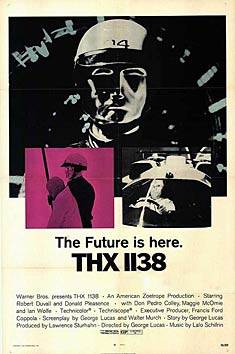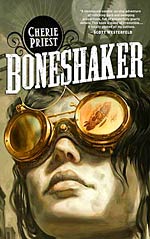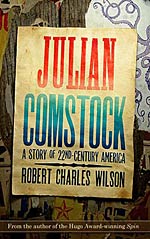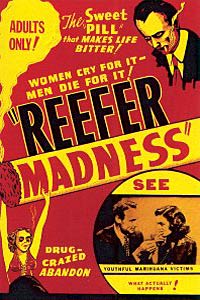Waiting for the Man
Now I don’t intend to get overly political here. But let’s face it.
Government-run healthcare is one of the “big ideas” frequently explored in science fiction.
With sci fi films often functioning as social commentators, the idea of Big Health has been played out many times before. One of the more fascinating of these Cassandras was George Lucas’s THX 1138. It has all the elements.
Big Government. White pajamas. Severe haircuts. Compulsory drug addiction. Poor décor choices.
Though we’re never certain where THX 1138 takes place, we can deduce that it’s either a dystopia or EDS.
THX 1138 features Bob Duvall in a bravura performance as THX, a Boo Radley getting his “Billy Corgan” on. Coincidentally named after the license plate number on my dad’s puke green Chevy Nova, Bob holds down a gig at Chernobyl, building the android Erik Estradabots™ that provide security for the dystopia (or EDS).
Given the dangerous and mind-numbing rigors of his employ, Bob needs to be dosed on heavy narcotics to be able to function at his job (it must be EDS). To make matters worse, sex is against the law, everyone’s hopped up on libido limpers and, completing the narrative crucible, Bob shares an apartment with a comely young woman named LUH (played by Maggie McOmie).
It doesn’t take long before LUH and Bob decide that things might heat up if they go cold turkey. (Note to self: when you find you’re constantly apologizing to your medicine cabinet, it’s time to call Betty Ford.) Taking Nancy Reagan’s advice to just say no, our young couple discovers that life really is more fun without clothes. For awhile, things are peaches and cream.
But without his prescriptions, Bob finds it that much harder to work at Chernobyl. Compounding matters, enter creepy stalker Donald Pleasence (this was 10 years before Pleasence entered politics, got elected President and subsequently crashed into the New York Maximum Security Penitentiary).
Donald, as LUH’s boss, sabotages Bob and LUH’s sexcapades by assigning LUH to the nightshift. The creep factor is that Donald did it because he wants to take LUH’s place as Bob’s roommate. Yikes! What’s up with that, George Lucas? Keep this guy out of men’s rooms in Idaho, for pete’s sake!
 It doesn’t take long for Bob and LUH to get busted for evading their healthcare obligations. Bob is briefly thrown in prison with LUH and they commence to, er, you know, but they are cracked down in mid-canoodle by the Estradabots. Bob is re-located to an area with other male prisoners, including the Donald. (Yikes! Can I get away from this guy?)
It doesn’t take long for Bob and LUH to get busted for evading their healthcare obligations. Bob is briefly thrown in prison with LUH and they commence to, er, you know, but they are cracked down in mid-canoodle by the Estradabots. Bob is re-located to an area with other male prisoners, including the Donald. (Yikes! Can I get away from this guy?)
Sparing you the details, Bob makes an escape with the Donald and another guy. Chased by the Estradabots through the streets of EDS, they are split up. The Donald attacks a priest and then later is apprehended talking with kids. Goodbye, Uncle Ernie!
Bob and the other guy, doing their best Defiant Ones impression, sneak into EDS’ IT server room, where Bob discovers that LUH has been permanently outsourced. Busting loose, our boys carjack a couple of Mach 5s and make a break for it, Estradabots in hot pursuit.
 Though the other guy crashes his car, Bob reaches the EDS city limits and clambers up a ladder to freedom. EDS determines it’s spent too much already for Bob’s apprehension, and the Estradabots are ordered off the case. Bob emerges at the top of the ladder, resume in hand, sober, lonely and gainfully unemployed.
Though the other guy crashes his car, Bob reaches the EDS city limits and clambers up a ladder to freedom. EDS determines it’s spent too much already for Bob’s apprehension, and the Estradabots are ordered off the case. Bob emerges at the top of the ladder, resume in hand, sober, lonely and gainfully unemployed.
For their part, the Estradabots would re-emerge as Max Von Sydow’s hockey squad in Strange Brew, thanks to their dexterous stickwork.
With all the recent hullabaloo surrounding healthcare, it seemed timely to remind our loyal readers of this film.
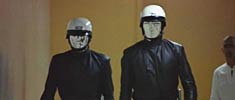 From Brave New World to Logan’s Run, and on and on, the idea that your medical requirements are best serviced by the government is an idea that has gained a lot of imaginative speculation over time.
From Brave New World to Logan’s Run, and on and on, the idea that your medical requirements are best serviced by the government is an idea that has gained a lot of imaginative speculation over time.
Politically speaking, I suppose the antithesis of big government health care would be mega-corporate private healthcare. But with films like Repo Men and Resident Evil, science fiction shows us that you essentially get the same result: a paucity of genuine human compassion that would make even Blue Cross/Blue Shield cringe.
The moral of today’s column?
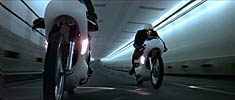 If someone wants to size you for government-issued pajamas, run!
If someone wants to size you for government-issued pajamas, run!
Watching THX 1138, I found it particularly chilling when one of the Estradabots said to our man Bob, “Everything will be all right. You are in my hands. I am here to protect you. You have nowhere to go. You have nowhere to go”.
I’m not entirely sure, but I think Nancy Pelosi said the same thing on the House floor.
Free Sci-Fi Books for the iPhone
For all you iPhone and iPad users, there is a free app that includes more than 700 classic science fiction novels.
Free Science Fiction Books unlocks a massive collection of public domain sci-fi, from the pulp sci-fi of Edgar Rice Burroughs, to the politically charged space stories of H.G. Wells and deep sea adventures of Jules Verne. Other authors include: Stanley Weinbaum, Jack London, E.M. Forster, Arthur Conan Doyle, and Mary Wollstonecraft Shelley. And all, might we belabor the point, absolutely free.
The 2009 British Science Fiction Association Award Winner
 The winner of the 2009 British Science Fiction Association award for best novel has been announced. The winner is:
The winner of the 2009 British Science Fiction Association award for best novel has been announced. The winner is:
The City & The City by China Miéville (Del Rey; Macmillan UK)
Thanks to Cheryl Morgan at conventionreporter.com for the live coverage of the event and for breaking the news.
Congrats to China Miéville on the win. In the other awards news today The City & the City was nominated for the 2010 Hugo to go with China’s other nominations: the 2009 Nebula and the 2010 Arthur C. Clarke. We’ve not heard the last on this book for sure.
So who’s read The City & the City and what did you think? How does this one compare to China’s other books?
2010 Hugo Award Nominees
The nominees for the 2010 Hugo Award have been announced at Aussiecon 4, the 68th World Science Fiction Convention. They Best Novel category nominees are:
- Boneshaker, Cherie Priest (Tor)
- The City & The City, China Miéville (Del Rey; Macmillan UK)
- Julian Comstock: A Story of 22nd-Century America, Robert Charles Wilson (Tor)
- Palimpsest, Catherynne M. Valente (Bantam Spectra)
- WWW: Wake, Robert J. Sawyer (Ace; Penguin; Gollancz; Analog)
- The Windup Girl, Paolo Bacigalupi (Night Shade)
See the complete list of nominees in all categories on the official Hugo Award website.
What do you think of this lineup? Anybody got a favorite on this list?
2009 Philip K. Dick Award Winner
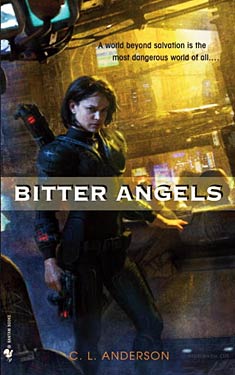 The 2009 Philip K. Dick Award Winner has been announced!
The 2009 Philip K. Dick Award Winner has been announced!
From the official press release:
It was announced on Friday, April 2, at Norwescon 33, in SeaTac, Washington, that the winner for the distinguished original science fiction paperback published for the first time during 2009 in the U.S.A. is:
Bitter Angels by C. L. Anderson (Ballantine Books Spectra)
Special citation was given to:
Cyberabad Days by Ian McDonald (Pyr)
Congratulations to all the nominees.
Laser Madness
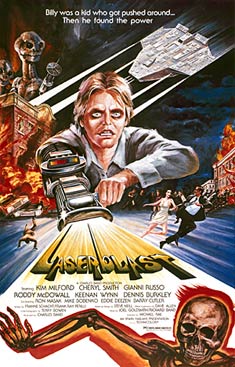 I’m not much of a film critic.
I’m not much of a film critic.
I can admit it. The reason I can admit it is that I know I just don’t have the heart to slam a movie just because it’s a bad movie.
For me, “bad” is not enough of a qualifier to unleash on a film. Picking on a bad movie is like kicking a guy when he’s down. They’ve suffered enough. I’d rather save the sarcasm for the movies (and filmmakers) who are wildly successful. They can take it.
Having tried my hand at screenwriting (and having no luck at it), I learned to respect the process. I’ve been there. The shameless hawking of a story idea to anyone who’d listen. The rewrites of rewrites. Query letters. Trying to get an agent. Plowing through screenwriting books. All that.
If nothing else, the experience taught me that if a person actually does get a story turned into a movie, that’s really something. It’s a lot of work, and you really have to care strongly about what you’re doing if you even want a shot at seeing it through.
To sell a screenplay is a big deal. To see it then turned into a movie is a huge deal.
I firmly believe no one ever sets out to write a bad movie.
Because of this, I give “bad” movies slack. I try to look beyond their faults and weigh what their creators were trying to do or say.
All this is lead up for today’s review of what has been universally reviled as one of the worst movies of all time. The 1978 science fiction opus known as Laserblast.
For those of you unfamiliar with the film, it relates the tale of Billy, whom we are to understand is a much put-upon teenager, and the aftermath of his discovery of an extraterrestrial weapon of mass destruction. We follow Billy as he goes on a rampage against those who torment him, before finally descending into madness, mutation and eventual death at the hands of the aliens who return to Earth to reclaim the weapon.
Having watched it last night, my head is still awash in its non sequitur narrative and undisciplined editing. Admittedly, the movie almost begs to be mocked. The dialogue. The acting. The effects, which fail one of the fundamental rules of science fiction cinema, a little something I call “The Krofft Rule.”
Essentially the rule states that your special effects m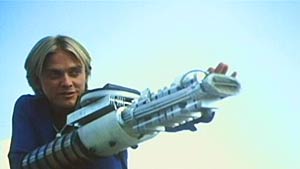 ust be measurably better than something that Sid and Marty Krofft manufactured during their TV entertainment heyday. If you’re rolling out a full-fledged film and you can’t outshine the Krofts’ “Grumpy the Tyrannosaurus,” you’re in big trouble.
ust be measurably better than something that Sid and Marty Krofft manufactured during their TV entertainment heyday. If you’re rolling out a full-fledged film and you can’t outshine the Krofts’ “Grumpy the Tyrannosaurus,” you’re in big trouble.
I knew Grumpy. Grumpy was a friend of mine. And Laserblast, you’re no Grumpy.
Laserblast featured (“starred” is too strong a word choice) Kim Milford as Billy. For you Jeff Beck freaks out there, Kim sang lead vocals for the Jeff Beck Group for roughly two weeks during the summer of 1972. (You would have to be a pathological Jeff Beck fan to know that, which I’m not.)
Milford would find more rewarding work as the villain opposite Mark Hamill (aka Luke Skywalker) in one of cinema’s greatest triumphs of the late 1970s.
I’m talking, of course, about Corvette Summer.
Anyway, in Laserblast we follow Milford as he becomes a deranged mutant killer blasting cars, people and domiciles with the laser weapon that happenstance has placed in his care.
Rather than get hung up on its shortcomings, I spent some time reflecting on Laserblast and the message that its filmmakers might have been trying to tell us.
I think I’ve found something.
Laserblast is noteworthy in its nihilism in that the hero is also the villain. There is no real foil to Billy, until the very end when the aliens blast the rampaging youth in an act of supernatural justice.
As an audience, we are confused as to who we’re supposed to root for. Rather, we watch helplessly as our hero self-destructs. The fact that we don’t really care because the film is so bad is beside the point. This led me to surmise that Laserblast is actually a sort of cautionary tale. If it’s a cautionary tale, what are we being cautioned against?
Laserblast is the Reefer Madness of the space era.
Eureka! Of course. The parallels are obvious.
In Reefer Madness, troubled youth of the 1930s taste forbidden fruits, go insane and dead end in a fatal crime spree.
In Laserblast, troubled youth of the 1970s taste forbidden fruits, go insane and dead end in a fatal crime spree.
Looking at Laserblast from this angle, you can deduce deeper meanings behind the deaths of Billy’s victims. Also telling is who among the film’s cast survives Billy’s rampage.
In essence, almost no figure with real authority dies in the film. Not Billy’s absentee mother, who makes a brief cameo before jetting off to Acapulco. Not the mysterious government agent. Not Billy’s girlfriend’s grandfather, the Colonel. Not the hapless town sheriff.
The deaths are relegated to the two bumpkin deputies, two bullies (the most unlikely bullies you will ever meet – remember Mandark from Dexter’s Laboratory?), and Roddy McDowell.
(McDowell, who plays a doctor in the film and hence an authority figure, wasn’t supposed to die in the original script, but he begged to be off’d after he realized what the film was going to do to his career.)
So, no one of significant authority is killed. And in fact, it’s telling that the two bumpkin deputies are seen smoking a doobie early in the film, a precursor to later onscreen fatality if ever there was one.
Like Reefer Madness, Laserblast was intentionally mad e to demonstrate the inherent dangers of a forbidden fruit and to scare kids away from it.
e to demonstrate the inherent dangers of a forbidden fruit and to scare kids away from it.
In Laserblast’s case, that forbidden fruit was alien technology.
What it all boils down to is this. A government plot to keep us from using alien weapons of mass destruction.
Think I’m kidding?
Listen, in the late 70s we were still getting our outer space on. Shuttles, Voyager satellites, stuff like that. Who knew what kind of stuff we’d shake lose from the stars. You poke a finger at the stars, they might poke back.
Remember the times in which Laserblast was made. The year before, Richard Dreyfuss was making mashed potato sculptures and getting unexplained suntans.
The government had to hedge their bets. They had to spread the word.
If you find something that looks outer-spacey, don’t touch it! You could end up like Billy!
That’s right. Laserblast was a government propaganda film. How else could it have been so bad?



















 Full Details
Full Details
